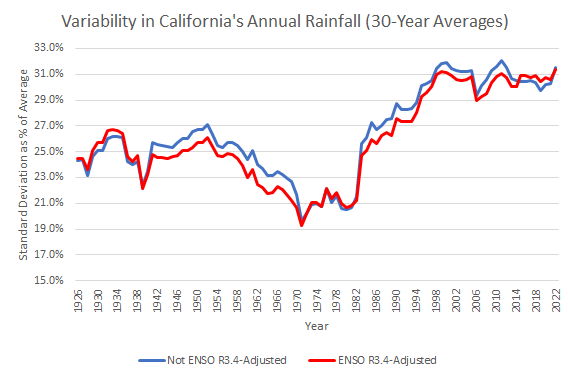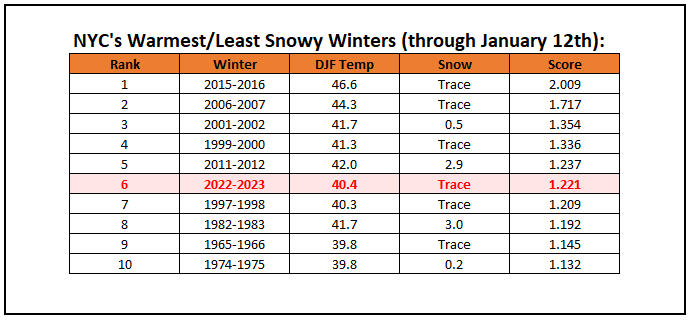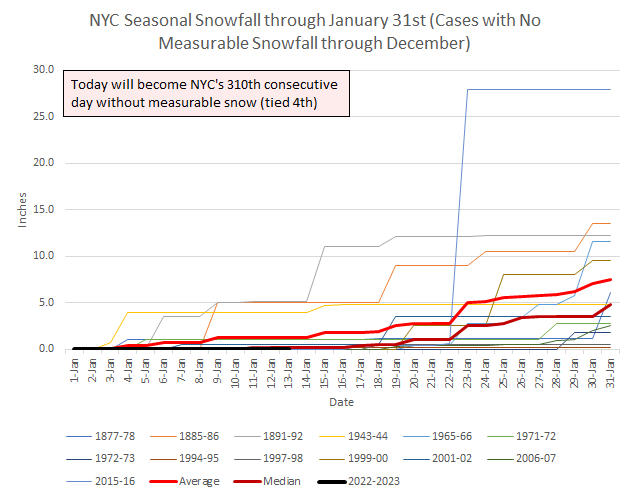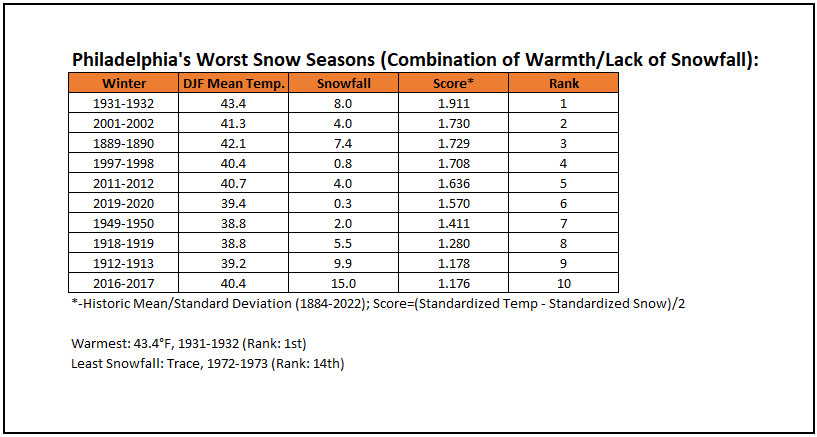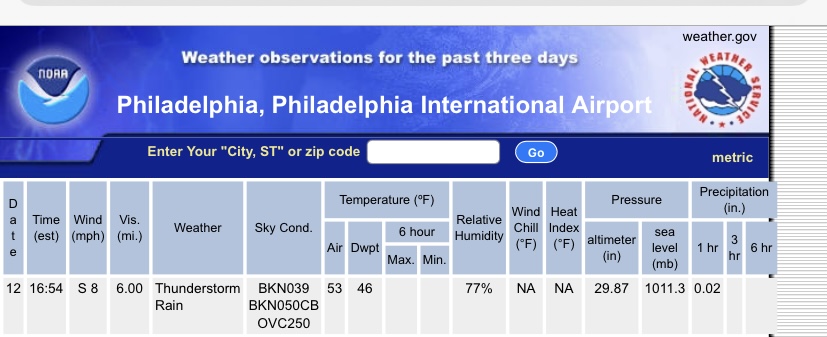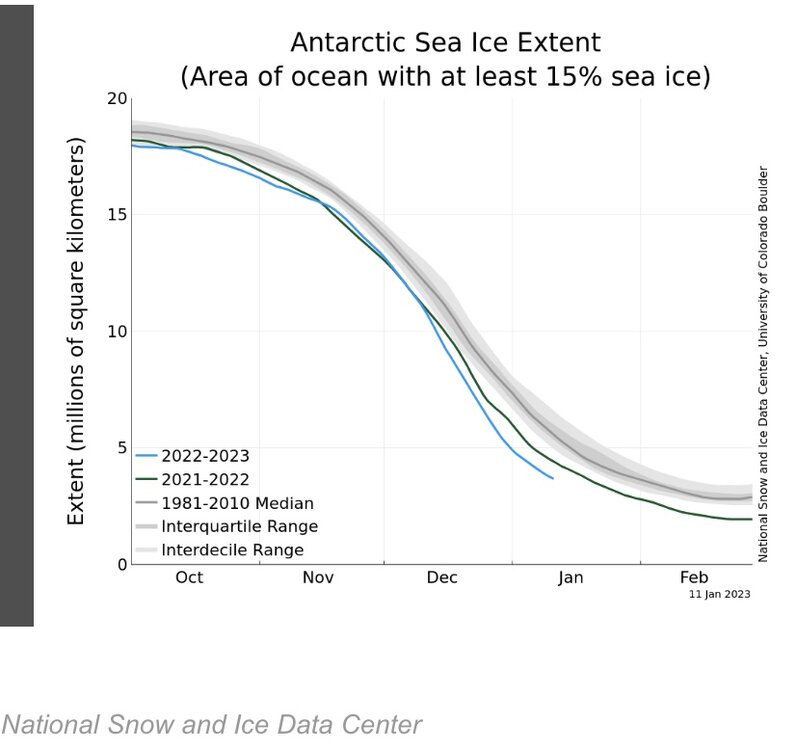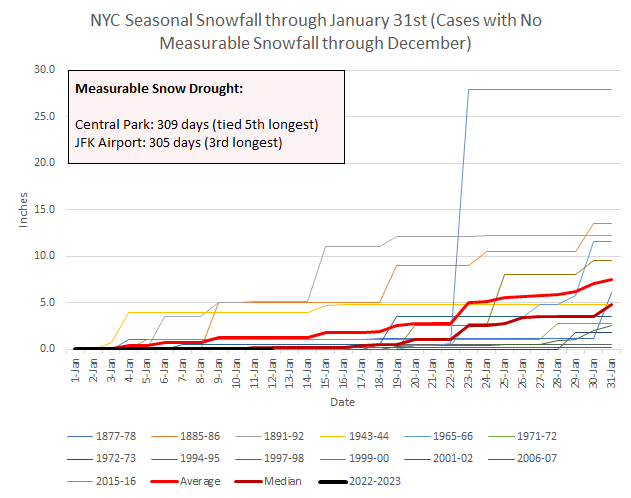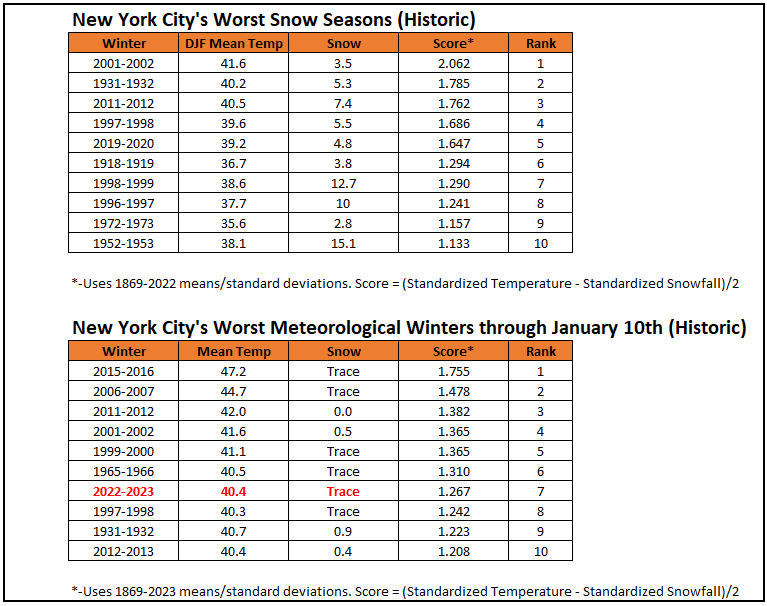-
Posts
22,981 -
Joined
Content Type
Profiles
Blogs
Forums
American Weather
Media Demo
Store
Gallery
Everything posted by donsutherland1
-
A seasonably cool air mass is pushing into the region for the the weekend. An offshore storm could spread clouds into the region Sunday into Monday. Parts of eastern Long Island and eastern New England, including Boston, could see a period of snow. Right now, the odds favor a light to perhaps moderate snowfall in that area. Farther west, the measurable snow drought will very likely continue in Philadelphia and New York City. Milder weather will then return and persist through much of next week. The ENSO Region 1+2 anomaly was -0.3°C and the Region 3.4 anomaly was -0.7°C for the week centered around December 28. For the past six weeks, the ENSO Region 1+2 anomaly has averaged -0.48°C and the ENSO Region 3.4 anomaly has averaged -0.87°C. La Niña conditions will likely persist through mid-winter before fading to neutral conditions. The SOI was -14.93 today. The preliminary Arctic Oscillation (AO) was -1.028 today. On January 11 the MJO was in Phase 8 at an amplitude of 0.529 (RMM). The January 10-adjusted amplitude was 0.747 (RMM). Based on sensitivity analysis applied to the latest guidance, there is an implied 99% probability that New York City will have a warmer than normal January (1991-2020 normal). January will likely finish with a mean temperature near 40.6° (6.9° above normal).
-
5/11 (45%) cases. January-February Lowest AO in such winters: 1950-51: -2.718 1963-64: -3.371 1965-66: -2.225 1995-96: -3.607 2010-11: -3.806
-
Currently, Winter 2022-2023 ranks among the 10 worst winters to date in NYC through January 12th (standardized temperatures and snowfall).
-

Unable to Renew Subscription
donsutherland1 replied to donsutherland1's topic in Forum Information & Help
Many thanks. That was last year. It’s all fine, now. -
Morning thoughts… Showers and drizzle will end this morning. The remainder of the day will be mostly cloudy. It will be unseasonably mild, but cooler air will begin to move into the region late in the day. High temperatures will reach the lower and middle 50s in most areas. Likely high temperatures around the region include: New York City (Central Park): 56° Newark: 57° Philadelphia: 55° A seasonably cool weekend lies ahead. Normals: New York City: 30-Year: 39.2°; 15-Year: 40.1° Newark: 30-Year: 39.7°; 15-Year: 40.8° Philadelphia: 30-Year: 41.1°; 15-Year: 41.9°
-
Hopefully, things will improve.
-
-
Thunderstorms affected Philadelphia, Newark, and JFK Airport this evening. Additional rain is likely tonight into tomorrow. A general 0.50"-1.00" rainfall is likely. Temperatures will be well above seasonal norms. Following the storm, a seasonably cool air mass will overspread the region for the close of the week. An offshore storm could spread clouds into the region Sunday into Monday. Parts of eastern Long Island and eastern New England, including Boston, could see a period of snow. Farther west, the measurable snow drought will likely continue in Philadelphia and New York City. Milder weather will then return and persist through much of next week. The ENSO Region 1+2 anomaly was -0.3°C and the Region 3.4 anomaly was -0.7°C for the week centered around December 28. For the past six weeks, the ENSO Region 1+2 anomaly has averaged -0.48°C and the ENSO Region 3.4 anomaly has averaged -0.87°C. La Niña conditions will likely persist through mid-winter before fading to neutral conditions. The SOI was -0.80 today. The preliminary Arctic Oscillation (AO) was -0.609 today. On January 10 the MJO was in Phase 7 at an amplitude of 0.745 (RMM). The January 9-adjusted amplitude was 0.914 (RMM). Based on sensitivity analysis applied to the latest guidance, there is an implied 99% probability that New York City will have a warmer than normal January (1991-2020 normal). January will likely finish with a mean temperature near 40.6° (6.9° above normal).
-

E PA/NJ/DE Winter 2022-2023 OBS Thread
donsutherland1 replied to Ralph Wiggum's topic in Philadelphia Region
-

Report: Another Year of Record Heat for the Oceans
donsutherland1 replied to donsutherland1's topic in Climate Change
I believe we will get a good example of where things stand this year and next year as the La Niña ends. I suspect that the outcome will validate some acceleration in the rate of warming with this year winding up among the 3 warmest years and next year probably setting a record. The warmth after 3 years of La Niña is stunning. Even a weak El Niño could produce record warmth as anthropogenic greenhouse gas forcing continues to grow. -
-
A lot can change on the guidance in that timeframe. It does look to get back to at least a period of seasonably cold weather as the month nears an end.
-
It will be tough. We'd have to go through all of January and then through the first five days of February to set the mark. It's not impossible, but a lot can change over a 3-week timeframe.
-
Yes. The record for JFK and Central Park is 332 consecutive days.
-
Today will become the 309th consecutive day during which Central Park has received no measurable snowfall. That will tie March 15, 1997 - January 17, 1998 for the 5th longest stretch without measurable snowfall.
-
Morning thoughts… Showers are likely this morning. A steadier rain could develop late this afternoon or tonight. It will turn much milder. High temperatures will reach the lower and middle 50s in most areas. Likely high temperatures around the region include: New York City (Central Park): 53° Newark: 55° Philadelphia: 56° Rain will end tomorrow. A seasonably cool weekend will follow. Normals: New York City: 30-Year: 39.3°; 15-Year: 40.2° Newark: 30-Year: 39.8°; 15-Year: 40.9° Philadelphia: 30-Year: 41.1°; 15-Year: 42.0°
-
Clouds will increase tonight as a storm moves toward Lake Erie. Temperatures could begin to rise toward morning. Afterward, that storm will head up the St. Lawrence River Valley. That storm will bring a period of rain to the region tomorrow evening into Friday. A general 0.50"-1.00" rainfall is likely. Following the storm, a seasonably cool air mass will overspread the region for the close of the weekend. However, milder weather will follow early next week. The ENSO Region 1+2 anomaly was -0.3°C and the Region 3.4 anomaly was -0.7°C for the week centered around December 28. For the past six weeks, the ENSO Region 1+2 anomaly has averaged -0.48°C and the ENSO Region 3.4 anomaly has averaged -0.87°C. La Niña conditions will likely persist through mid-winter before fading to neutral conditions. The SOI was +7.02 today. The preliminary Arctic Oscillation (AO) was -0.711 today. On January 9 the MJO was in Phase 7 at an amplitude of 0.912 (RMM). The January 8-adjusted amplitude was 0.872 (RMM). Based on sensitivity analysis applied to the latest guidance, there is an implied 98% probability that New York City will have a warmer than normal January (1991-2020 normal). January will likely finish with a mean temperature near 40.6° (6.9° above normal).
-
2011-12 had the October snowstorm that led to a less severe departure on seasonal snowfall.
-
I agree. In terms of warmth and lack of snowfall, 2001-02 was the worst.
-
So far, 2022-2023 is among the worst meteorological winters (December 1-January 10) on record in New York City. This should come as no surprise to anyone here. If it keeps doing what it's doing, it would join the ranks of worst snow seasons on record.
-
It's been really bad. A lot of winter-dependent industries are suffering.
-
For now. But beyond 10 days, model skill falls dramatically, so things can still change. It could turn cooler during the last week of the month. The magnitude is uncertain. The duration of such cooling, if it occurs, is also uncertain.
-
No. It just missed.




